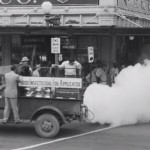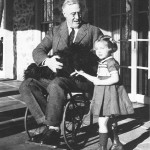SciTech Tuesday–Roosevelt’s Death and Polio
It was April 12th, 1945, just over a month after he had reported to Congress on the Yalta Conference, and just less than a month before Truman announced Victory in Europe, that Franklin Delano Roosevelt died. That afternoon, at his vacation home in Warm Springs GA, where he had gone to rest before the Inauguration of The United Nations, he declared “I have a terrific pain in the back of my head,” before slumping forward unconscious. He died shortly after, with the death attributed to a stroke.
In 1921, when he was 39, Roosevelt was diagnosed with Poliomyelitis. This disease is caused by an infection of an enterovirus. The Poliovirus is one of the simplest viruses, containing a strand of RNA in a protein capsule. Infection is oral, and in the vast majority of cases results in no symptoms. In a very small number of cases it results in muscle paralysis, and can lead to serious motor problems and even death if it affects the diaphragm.
In the early part of this century Polio was greatly feared, since it strikes almost exclusively children and onset is rapid. Sometimes it was thought to be transmitted by insects, and led to the spraying of DDT, in others to the closure of swimming pools. The development of the Inactivated Polio Vaccine (IPV) by Jonas Salk in 1955 began the near eradication of the disease. There are still hotspots of infection, particularly in Afghanistan and Nigeria, but in recent years there have been only about 200 cases per year reported.
Roosevelt was diagnosed after developing a fever and losing strength in his legs over a couple of days. He had jogged and swam and hiked just before that–being an active man–and so it is unclear where he was exposed. It is rare to be infected past childhood, but Polio is the diagnosis that best fit his symptoms. He used braces to walk, a modified car that didn’t have foot controls, and a wheelchair the rest of his life. Age and the strain of events wore on him in the later years of his presidency. Observers of his speech to Congress about the Yalta Conference noted how he seemed aged and less energetic, and he sat through the address.
One of the dangers for those with partial paralysis is the development of blood clots. It may have been such a clot that led to Roosevelt’s stroke. If so, the Polio may have led to his death, but that’s not certain.
It is certain that without the developments of technology and government support of research that took place in the Depression and war years, innovations such as Salk’s vaccine would not have occurred. The systems put in place to win the war, to develop Big Science and Big Industry, continued in the post-war years.
- Three girls in Charity Hospital New Orleans' ward for Polio cases.
- In Austin TX a truck sprays DDT to eliminate insects, which were incorrectly blamed for the spread of Polio
- Roosevelt generally avoided public appearances and photographs that revealed his disability.
- The Polio virus is one of a kind of RNA viruses that that require cells to make DNA for them to replicate.
All images from the National Archives
Posted by Rob Wallace, STEM Education Coordinator at The National WWII Museum








Leave a Reply